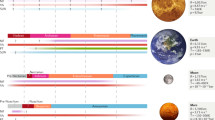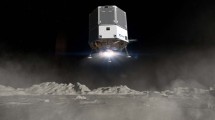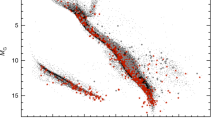Abstract
The number of known exoplanets rose from zero to one in the mid-1990s, and has been doubling approximately every two years ever since. Although this can justifiably be called the beginning of an era, an earlier era began in the 1960s when humankind began exploring the Solar System with spacecraft. Even earlier than that, the era of modern scientific study of the Solar System began with Copernicus, Galileo, Brahe, Kepler and Newton. These eras overlap in time, and many individuals have worked across all three. This Review explores what the past can tell us about the future and what the exploration of the Solar System can teach us about exoplanets, and vice versa. We consider two primary examples: the history of water on Venus and Mars; and the study of Jupiter, including its water, with the Juno spacecraft.
This is a preview of subscription content, access via your institution
Access options
Access Nature and 54 other Nature Portfolio journals
Get Nature+, our best-value online-access subscription
$29.99 / 30 days
cancel any time
Subscribe to this journal
Receive 12 digital issues and online access to articles
$119.00 per year
only $9.92 per issue
Buy this article
- Purchase on Springer Link
- Instant access to full article PDF
Prices may be subject to local taxes which are calculated during checkout


NASA/JPL-CALTECH/SWRI/MSSS

NASA/JPL-CALTECH/SWRI/MSSS

NASA/JPL-CALTECH/SPACE SCIENCE INSTITUTE
Similar content being viewed by others
References
Galilei, G. Siderius Nuncius (1610).
Copernicus, N. De Revolutionibus Orbium Coelestium (1543).
Kepler, J. Astronomia Nova (1609).
Newton, I. Principia Mathematica (1687).
Cavendish, H. Experiments to determine the density of the Earth. Phil. Trans. Roy. Soc. 88, 469–526 (1798).
Marcy, G. W. et al. The planet around 51 Pegasi. Astrophys. J. 481, 926–935 (1997).
Butler, R. P. et al. Attaining Doppler precision of 3 m s−1. Pub. Astron. Soc. Pacific 108, 500–509 (1996).
Borucki, W. J. et al. Kepler planet-detection mission: Introduction and first results. Science 327, 977–980 (2010).
Menzel, D. H., Coblentz, W. W. & Lampland, C. O. Planetary temperature derived from water-cell transmissions. Astrophys. J. 63, 177–187 (1926).
Adel, A. & Slipher, V. M. The constitution of the atmospheres of the giant planets. Phys. Rev. 46, 902–906 (1934).
Kiess, C. C., Corliss, C. H. & Kiess, H. K. High-dispersion spectra of Jupiter. Astrophys. J. 132, 221–231 (1960).
Charbonneau, D., Brown, T. M., Noyes, R. W. & Gilliland, R. L. Detection of an extrasolar planet atmosphere. Astrophys. J. 568, 377–384 (2002).
Deming, D. et al. Infrared transmission spectroscopy of the exoplanets HD 209458b and XO-1b using the wide field camera-3 on the Hubble Space Telescope. Astrophys. J. 774, 95 (2013).
Kreidberg, L. et al. A precise water abundance measurement for the hot Jupiter WASP-43b. Astrophys. J. Lett. 793, L27 (2014).
Kreidberg, L. et al. Clouds in the atmosphere of the super-Earth exoplanet GJ 1214b. Nature 505, 69–72 (2014).
Knutson, H. A. et al. 3.6 and 4.5 μm phase curves and evidence for non-equilibrium chemistry in the atmosphere of extrasolar planet HD 189733b. Astrophys. J. 754, 22 (2012).
Showman, A. P. & Guillot, T. Atmospheric circulation and tides of ‘51 Pegasus b-like' planets. Astron. Astrophys. 385, 166–180 (2002).
Mallama, A., Wang, D. & Howard, R. A. Venus phase function and forward scattering from H2SO4 . Icarus 182, 10–22 (2006).
Owen, T., Barnun, A. & Kleinfeld, I. Possible cometary origin of heavy noble-gases in the atmospheres of Venus, Earth and Mars. Nature 358, 43–46 (1992).
Owen, T. & Barnun, A. Comets, impacts, and atmospheres. Icarus 116, 215–226 (1995).
Marty, B. The origins and concentrations of water, carbon, nitrogen and noble gases on Earth. Earth Planet. Sci. Lett. 313, 56–66 (2012).
Altwegg, K. et al. 67P/Churyumov–Gerasimenko, a Jupiter family comet with a high D/H ratio. Science 347, 1261952 (2015).
Barnes, J. J. et al. An asteroidal origin for water in the Moon. Nat. Commun. 7, 11684 (2016).
Komabayashi, M. Discrete equilibrium temperatures of a hypothetical planet with the atmosphere and hydrosphere of one component-two phase system under constant solar radiation. J. Meteor. Soc. Jpn 45, 137–139 (1967).
Ingersoll, A. P. The runaway greenhouse: A history of water on Venus. J. Atmos. Sci. 26, 1191–1198 (1969).
Nakajima, S., Hayashi, Y. Y. & Abe, Y. A study on the runaway greenhouse-effect with a one-dimensional radiative convective equilibrium-model. J. Atmos. Sci. 49, 2256–2266 (1992).
Kasting, J. F. Runaway and moist greenhouse atmospheres and the evolution of Earth and Venus. Icarus 74, 472–494 (1988).
Pujol, T. & North, G. R. Runaway greenhouse effect in a semigray radiative-convective model. J. Atmos. Sci. 59, 2801–2810 (2002).
Kasting, J. F., Chen, H. & Kopparapu, R. K. Stratospheric temperatures and water loss from moist greenhouse atmospheres of Earth-like planets. Astrophys. J. Lett. 813 L3 (2015).
Howard, A. D., Moore, J. M. & Irwin, R. P. An intense terminal epoch of widespread fluvial activity on early Mars: 1. Valley network incision and associated deposits. J. Geophys. Res. Planets 110 E12S14 (2005).
Malin, M. C. & Edgett, K. S. Evidence for persistent flow and aqueous sedimentation on early Mars. Science 302, 1931–1934 (2003).
Wordsworth, R. D. in Annu. Rev. Earth Planet. Sci. Vol. 44 (eds Jeanloz, R. & Freeman, K. H. ) 381–408 (2016).
Bibring, J. P. et al. Global mineralogical and aqueous Mars history derived from OMEGA/Mars express data. Science 312, 400–404 (2006).
Ehlmann, B. L. et al. Orbital identification of carbonate-bearing rocks on Mars. Science 322, 1828–1832 (2008).
Ehlmann, B. L. et al. Subsurface water and clay mineral formation during the early history of Mars. Nature 479, 53–60 (2011).
Smith, M. D. The annual cycle of water vapor on Mars as observed by the thermal emission spectrometer. J. Geophys. Res. Planets 107, E11 (2002).
Malin, M. C. & Edgett, K. S. Evidence for recent groundwater seepage and surface runoff on Mars. Science 288, 2330–2335 (2000).
McEwen, A. S. et al. Seasonal flows on warm Martian slopes. Science 333, 740–743 (2011).
Ingersoll, A. P. Mars: Occurrence of liquid water. Science 168, 972–973 (1970).
Chevrier, V. F. & Rivera-Valentin, E. G. Formation of recurring slope lineae by liquid brines on present-day Mars. Geophys. Res. Lett. 39, L21202 (2012).
Ojha, L. et al. Spectral evidence for hydrated salts in recurring slope lineae on Mars. Nat. Geosci. 8, 829–832 (2015).
Bahcall, J. N., Huebner, W. F., Lubow, S. H., Parker, P. D. & Ulrich, R. K. Standard solar models and the uncertainties in predicted capture rates of solar neutrinos. Revs. Mod. Phys. 54, 767–800 (1982).
Minton, D. A. & Malhotra, R. Assessing the massive young sun hypothesis to solve the warm young Earth puzzle. Astrophys. J. 660, 1700–1706 (2007).
Kasting, J. F. CO2 condensation and the climate of early Mars. Icarus 94, 1–13 (1991).
Forget, F. et al. 3D modelling of the early martian climate under a denser CO2 atmosphere: Temperatures and CO2 ice clouds. Icarus 222, 81–99 (2013).
Wordsworth, R. D., Kerber, L., Pierrehumbert, R. T., Forget, F. & Head, J. W. Comparison of ‘warm and wet' and ‘cold and icy' scenarios for early Mars in a 3-D climate model. J. Geophys. Res. Planets 120, 1201–1219 (2015).
Boynton, W. V. et al. Distribution of hydrogen in the near surface of Mars: Evidence for subsurface ice deposits. Science 297, 81–85 (2002).
Jakosky, B. M. et al. The Mars Atmosphere and Volatile Evolution (MAVEN) mission. Space Sci. Rev. 195, 3–48 (2015).
Jakosky, B. M., Grebowsky, J. M., Luhmann, J. G. & Brain, D. A. Initial results from the MAVEN mission to Mars. Geophys. Res. Lett. 42, 8791–8802 (2015).
Jontof-Hutter, D., Rowe, J. F., Lissauer, J. J., Fabrycky, D. C. & Ford, E. B. The mass of the Mars-sized exoplanet Kepler-138 b from transit timing. Nature 522, 321–323 (2015).
Niemann, H. B. et al. The composition of the Jovian atmosphere as determined by the Galileo probe mass spectrometer. J. Geophys. Res. Planets 103, 22831–22845 (1998).
Folkner, W. M., Woo, R. & Nandi, S. Ammonia abundance in Jupiter's atmosphere derived from the attenuation of the Galileo probe's radio signal. J. Geophys. Res. Planets 103, 22847–22855 (1998).
Mahaffy, P. R. et al. Noble gas abundance and isotope ratios in the atmosphere of Jupiter from the Galileo probe mass spectrometer. J. Geophys. Res. Planets 105, 15061–15071 (2000).
Stevenson, D. J. & Salpeter, E. E. Dynamics and helium distribution in hydrogen–helium fluid planets. Astrophys. J. Supp. Ser. 35, 239–261 (1977).
Atreya, S. K., Mahaffy, P. R., Niemann, H. B. & Owen, T. C. Composition and cloud structure of Jupiter's deep atmosphere. Highlights Astron. 12, 597–601 (2002).
Hersant, F., Gautier, D. & Lunine, J. I. Enrichment in volatiles in the giant planets of the Solar System. Planet. Space Sci. 52, 623–641 (2004).
Janssen, M. A. et al. Microwave remote sensing of Jupiter's atmosphere from an orbiting spacecraft. Icarus 173, 447–453 (2005).
Grassi, D. et al. Jupiter's hot spots: Quantitative assessment of the retrieval capabilities of future IR spectro-imagers. Planet. Space Sci. 58, 1265–1278 (2010).
Poincare, H. Sur la precession des corps deformables. Bull. Astron. 27, 321–356 (1910).
Kaspi, Y., Flierl, G. R. & Showman, A. P. The deep wind structure of the giant planets: Results from an anelastic general circulation model. Icarus 202, 525–542 (2009).
Fletcher, L. N., Orton, G. S., Teanby, N. A., Irwin, P. G. J. & Bjoraker, G. L. Methane and its isotopologues on Saturn from Cassini/CIRS observations. Icarus 199, 351–367 (2009).
Fletcher, L. N., Orton, G. S., Teanby, N. A. & Irwin, P. G. J. Phosphine on Jupiter and Saturn from Cassini/CIRS. Icarus 202, 543–564 (2009).
Fletcher, L. N. et al. Sub-millimetre spectroscopy of Saturn's trace gases from Herschel/SPIRE. Astron. Astrophys. 539, A44 (2012).
Militzer, B., Hubbard, W. B., Vorberger, J., Tamblyn, I. & Bonev, S. A. A massive core in Jupiter predicted from first-principles simulations. Astrophys. J. Lett. 688, L45 (2008).
Helled, R. & Guillot, T. Interior models of Saturn: Including the uncertainties in shape and rotation. Astrophys. J. 767, 113 (2013).
Hubbard, W. B. Gravitational signature of Jupiter's deep zonal flows. Icarus 137, 357–359 (1999).
Connerney, J. E. P., Acuna, M. H., Ness, N. F. & Satoh, T. New models of Jupiter's magnetic field constrained by the Io flux tube footprint. J. Geophys. Res. Space Phys. 103, 11929–11939 (1998).
Connerney, J. E. P., Ness, N. F. & Acuna, M. H. Zonal harmonic model of Saturn's magnetic field from Voyager 1 and 2 observations. Nature 298, 44–46 (1982).
Burton, M. E., Dougherty, M. K. & Russell, C. T. Saturn's internal planetary magnetic field. Geophys. Res. Lett. 37, 5 (2010).
Khurana, K. K. et al. in Jupiter: The Planet, Satellites, and Magnetosphere (ed. Bagenal, F. ) Ch. 24 (Cambridge Univ. Press, 2004).
Andre, N. et al. Identification of Saturn's magnetospheric regions and associated plasma processes: synopsis of Cassini observations during orbit insertion. Rev. Geophys. 46, RG4008 (2008).
Hill, T. W. Inertial limit on corotation. J. Geophys. Res. Space Phys. 84, 6554–6558 (1979).
de Pater, I. & Lissauer, J. J. Planetary Sciences 2nd edn (Cambridge Univ. Press, 2015).
Donahue, T. M. & Pollack, J. B. in Venus (eds Hunten, D. M., Collin, L., Donahue, T. M. & Moroz, V. I. ) 1003–1036 (Univ. Arizona Press, 1983).
Smith, D. E. et al. Mars orbiter laser altimeter: Experiment summary after the first year of global mapping of Mars. J. Geophys. Res. Planets 106, 23689–23722 (2001).
Phillips, R. J. et al. Massive CO2 ice deposits sequestered in the south polar layered deposits of Mars. Science 332, 838–841 (2011).
Ingersoll, A. P. Planetary Climates (Princeton Univ. Press, 2013).
Asplund, M., Grevesse, N., Sauval, A. J. & Scott, P. The chemical composition of the Sun. Ann. Rev. Astron. Astrophys. 47, 481–522 (2009).
Atreya, S. K. in Medicean Moons: Their Impact on 400 Years of Discovery (eds Barbieri, C., Chakrabarti, S., Coradini, M. & Lazzarin, M. ) 130–140 (Cambridge Univ. Press, 2010).
Bockelee-Morvan, D. et al. Deuterated water in comet C 1996 B2 (Hyakutake) and its implications for the origin of comets. Icarus 133, 147–162 (1998).
Donahue, T. M., Grinspoon, D. H., Hartle, R. E. & Hodges, R. R. in Venus II (eds Bougher, S. W., Hunten, D. M. & Phillips, R. J. ) Ch. 13 (Univ. Arizona Press, 1997).
Dyudina, U. A. et al. Saturn's south polar vortex compared to other large vortices in the Solar System. Icarus 202, 240–248 (2009).
Acknowledgements
This research was supported by NASA through the Juno and Cassini Projects.
Author information
Authors and Affiliations
Corresponding author
Ethics declarations
Competing interests
The author declares no competing financial interest.
Rights and permissions
About this article
Cite this article
Ingersoll, A. Three eras of planetary exploration. Nat Astron 1, 0010 (2017). https://doi.org/10.1038/s41550-016-0010
Received:
Accepted:
Published:
DOI: https://doi.org/10.1038/s41550-016-0010



